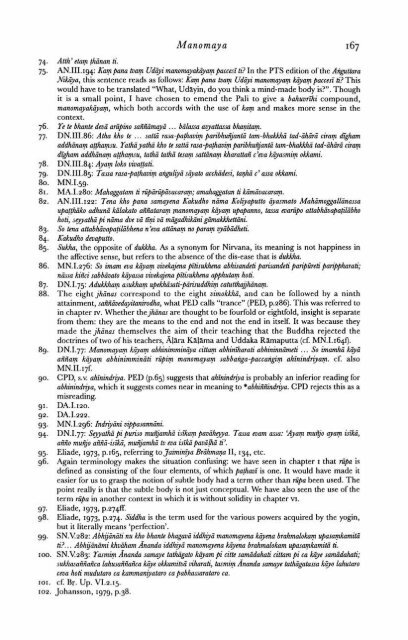Identity and Experience_Hamilton_1996
Identity and Experience_Hamilton_1996
Identity and Experience_Hamilton_1996
Create successful ePaper yourself
Turn your PDF publications into a flip-book with our unique Google optimized e-Paper software.
Manomaya 167<br />
Atth' etam thiinan ti.<br />
AN.111.194: Kam pana ham Ud9i manomayakaiampaccest Q In the PTS edition of the Ariguttara<br />
JKika>a, this sentence reads as follows: Kam pana tvam UdcTyi manomayam &yam paccesi ti? This<br />
would have to be translated "What, Udayin, do you think a mind-made body is?". Though<br />
it is a small point, I have chosen to emend the Pali to give a bahuvrihi compound,<br />
manomayakiiyam, which both accords with the use of kam <strong>and</strong> makes more sense in the<br />
context.<br />
Ye te bhante deuli anipino saiiiilimayi ... blilarra a yattma bhunitam.<br />
DN.III.86: Atha kho k ... sattZ rasa-pathavim paribhuiijanti tam-bhakkird tad-iihiirii cirap &%ham<br />
addhinam atthapsu. Tathiyah- kho te satti rtrra-pafi2avim paribhufijantii tam-bhakkhii tad-Ehiirh ciram<br />
dgham addhiinam atthapu, tathii tathii tesam sattiinam kharattafi c'eva kiiyasmim okkami.<br />
DN.III.84: Ayam loko vivat@ti.<br />
DN.III.85: Tma rasa-pathavim ariguliyii siiyab acchidesi, ta&- c' ma okkami.<br />
MN.I.59.<br />
MA.1.280: Mahaggatam ti 6piiriipiivacaram; amahaggatan ti kiimiivmaram.<br />
AN.111.121: Tena kho pana samayena Kakudho niima Koliyaputto iiyasmato Mahiimoggallinassa<br />
ufia#hiko adhunii kiilakato aiifiataram manomayam kiiyam upupanno, tma evanipo attabhiivapatilibho<br />
hoti, s~yathli pi nima due vi tini vii mZgadhikinigiimakkhettiini.<br />
So tma attabhiivapatiliibhena n'eva attiinam no param yiibidheti.<br />
Kakudho devaputto.<br />
Sukha, the opposite of dukkha. As a synonym for Nirvana, its meaning is not happiness in<br />
the affective sense, but refers to the absence of the dis-ease that is dukkha.<br />
MN. 1.276: So imam eva kqam uiuekajena pitkukhena abhis<strong>and</strong>eti paris<strong>and</strong>eti paripiireti parippharati;<br />
n&a kiiici sabbivato k gma vivekajena pitirukhena apphutam hoti.<br />
DN.I.75: Adukkham asukham upehati-pirisuddhim catutthqjhiinam.<br />
The eight jhiinas correspond to the eight vimokkhii, <strong>and</strong> can be followed by a ninth<br />
attainment, saiiiiiivedayitanirodha, what PED calls "trance" (PED, p.286). This was referred to<br />
in chapter rv. Whether thejhlinas are thought to be fourfold or eightfold, insight is separate<br />
from them: they are the means to the end <strong>and</strong> not the end in itselE It was because they<br />
made thejhinas themselves the aim of their teaching that the Buddha rejected the<br />
doctrines of two of his teachers, Alara Kalama <strong>and</strong> Uddaka Ramaputta (cf. MN.1.1640.<br />
DN.I.77: Manomayam kiiyam abhinimmin@a cittam abhiniharati abhininniimeti . .. So imamhii kiiyii<br />
aiiiiam kiyam abhinimminiiti riipim manomayam sabbariga-paccatigim ahinindriyam. cf.. also<br />
MN.11.17f;<br />
CPD, s.v. ahinindt-iya. PED (p.65) suggests that ahinindnya is probably an inferior reading for<br />
abhinindnya, which it suggests comes near in meaning to *abhit?tZnd';Ua. CPD rejects this as a<br />
misreading.<br />
DA.1.120.<br />
DA.I.222.<br />
MN. 1.296: Indnylini vippasanniini.<br />
DN.I.77: Sgyathli pi puriio muiijamhi kikam pavlihqya. Tma euam ma: 'Ayam muiijo ayam ki.)<br />
aKo muiZjo aiiiiii-isijGii) muiijamhii tv ma kikiipavii.& ti'.<br />
Eliade, 1973, p.165, referring toJaimin9a Brdzmana 11, 134, etc.<br />
Again terminology makes the situation confusing: we have seen in chapter I that nipa is<br />
defined as consisting of the four elements, of which pafi2avi is one. It would have made it<br />
easier for us to grasp the notion of subtle body had a term other than rtjpa been used. The<br />
point really is that the subtle body is not just conceptual. We have also seen the use of the<br />
term nipa in another context in which it is without solidity in chapter VI.<br />
Eliade, 1973, p.274fX<br />
Eliade, 1973, p.274. Siddha is the term used for the various powers acquired by the yogin,<br />
but it literally means 'perfection'.<br />
SN.V.282: AbhiinZti nu kho bhunte bhagavi iddhiyi manomayena kqena brahmalokam upasamkamitii<br />
ti?. . . Abhiiiniimi khviiham An<strong>and</strong>a iddhiyii manomayena Eyena brahmalokam u@samkamit?i ti.<br />
SN.V.283: Yasmim An<strong>and</strong>a samaye tathiigato kiiyam pi citte samiidahati cittam pi ca kiiye samiidahati;<br />
~ukhasafiiiaiica lahurailiiaiica kiiye okkamitui viharati, tasmim An<strong>and</strong>a samaye tathigatasra kiiyo Iahutaro<br />
ceua hoti mudutaro ca kammaniyataro ca pabhwarataro ca.<br />
cf. Br. Up. VI.2.15.<br />
Johansson, 1979, p.38.


